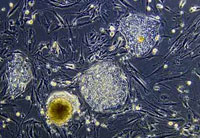Stem cells to rejuvenate mankind with the help of 50 billion dollars
US authorities have removed all obstacles on the way to the development of stem cell-based therapy. It became a landmark event for quite a number of reasons. It happened soon after Barack Obama took office as the new president of the United States. The Federal Drug Administration does not depend on the White House, although experts have every reason to believe that the new president could have a more pragmatic scientific approach to the issue of stem cell research.

“This message has to be taken very positively. I think that with this step America shows its understanding of the fact that scientific progress can not be stopped for either political or economic reasons,” Russian Academician Gennady Sukhikh said.
Indeed, he funding of the stem cell research under Bush’s rule was limited with 60 lines of embryo-obtained stem cells that were subsequently destroyed. US scientists said that only 20 of those lined remained suitable for research. The numerous restrictions, the scientists added, became a serious obstacle for any further works in the field.
The situation is different nowadays. The United States reportedly intends to invest about $50 billion in the stem cell research during only two years. This is very serious indeed.
Stem cells are the cells that are potentially capable of developing into the cells of any specialized tissues and organs. A stem cell is a self-renewable cell, i.e. it is virtually immortal. Secondly, stem cells can repeatedly generate colonies. Stem cells can be used to produce skin cells, brain cells, as well as liver, lungs, intestines, heart, vessel and connective tissue cells.
Geron Corp., America’s leading company in the field of stem cell research, plans to organize the clinical tests with the participation of several patients who suffered a paralysis as a result of spinal injuries. The company has already spent $170 million for the development of stem cell therapy.
Stem cells could be used to treat an infarction, to cure a spinal injury or diabetes. A doctor would simply make an injection of those cells into an injured organ and send the patient home very soon, for the stem cells would quickly produce the required muscle or nervous cells that an injury requires to recover.
The USA made the landmark decision to support the stem cell research in the middle of the economic crisis. One may say that America is showing an example for other countries of how to struggle against this crisis.
“Now The United States will be able to put an end to its own brain drain for many scientists have left the country and moved to Britain because of those restrictions. Britain can boast of having the most liberal legislation in this field,” Gennady Sukhikh said.
The FDA’s decision can exert influence on the views of Russian lawmakers too. Russia has very tough restrictions for clinical research in the field of stem cells. Many Russian experts say that it could be possible to weaken the resistance following America’s example and conduct at least primary clinical tests.
Embryonic stem cell lines are cultures of cells derived from the epiblast tissue of the inner cell mass (ICM) of a blastocyst or earlier morula stage embryos. A blastocyst is an early stage embryo—approximately four to five days old in humans and consisting of 50–150 cells. ES cells are pluripotent and give rise during development to all derivatives of the three primary germ layers: ectoderm, endoderm and mesoderm. In other words, they can develop into each of the more than 200 cell types of the adult body when given sufficient and necessary stimulation for a specific cell type. They do not contribute to the extra-embryonic membranes or the placenta.
After nearly ten years of research, there are no approved treatments or human trials using embryonic stem cells. Many nations currently have moratoria on either stem cell research or the production of new stem cell lines. Because of their combined abilities of unlimited expansion and pluripotency, embryonic stem cells remain a theoretically potential source for regenerative medicine and tissue replacement after injury or disease.
Subscribe to Pravda.Ru Telegram channel, Facebook, RSS!





